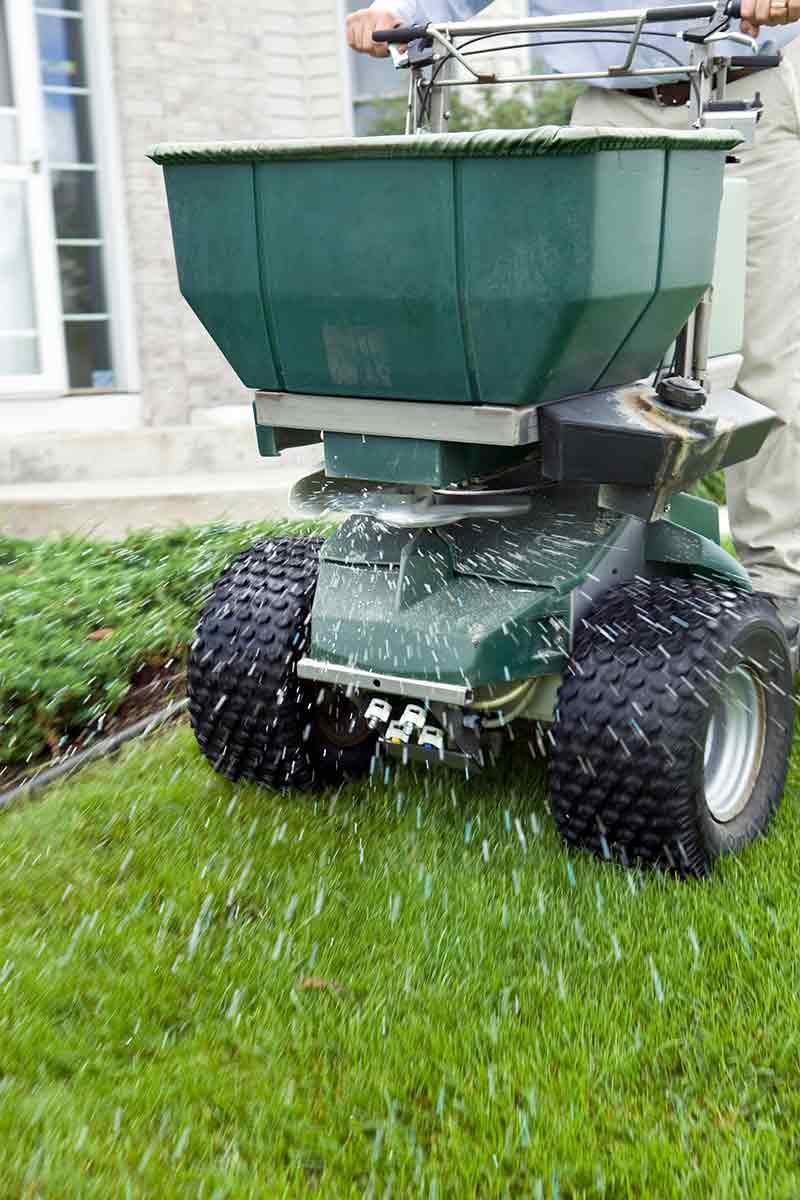Scotts Weed and Feed Early Fall Feeding
Fall's arrival brings changes in day length, temperature and precipitation, along with important changes in your lawn. Some lawn grasses and weeds begin to slow down and prepare for winter dormancy, but others kick into high gear. Feeding your fall lawn provides helpful nutrients to fight weeds and strengthen lawn grasses for the winter ahead. However, what and when to feed and how to manage weeds depends on your climate and the type of grass you grow.
Feeding Cool-Season Lawn Grasses

Cool-season grasses, such as Kentucky bluegrass, perennial ryegrass and fescues, flourish in northern regions with warm summers and cold winters. Cool, moderate, early fall temperatures send these grasses into their most active growth season, which is the ideal time for fertilizing and strengthening.
Start fertilizing cool-season grasses about six weeks before the average first frost in your area. Fresh out of summer dormancy, these grasses benefit from added fall nutrition, which spurs new shoot, stem and root growth, and helps increase their food reserves.1 September and October are prime cool-season fertilizing times for much of the United States.
A high-nitrogen lawn fertilizer with added potassium, such as Pennington UltraGreen Lawn Fertilizer 30-0-4, stimulates dense, healthy growth and supports winter and summer hardiness. The added boost of natural organisms from Pennington's Myco Advantage technology increases the surface area of grass roots, improving your lawn's ability to absorb water and nutrients, and enter winter prepared.
With broadleaf lawn weeds still actively growing in early fall, a weed & feed product such as Pennington UltraGreen Weed & Feed 30-0-4 fertilizes established cool-season lawns and kills a broad spectrum of common weeds through the help of three separate weed fighters. Follow label instructions closely to ensure you don't exceed annual limits for broadcast applications.
Fertilizing Warm-Season Grasses
 Warm-season grasses, such as Bermudagrass, bahiagrass, centipede grass and zoysia grass, thrive in southern regions and peak in growth during warm summer months. As fall approaches, their growth slows and dormancy sets in with the season's first killing frost.
Warm-season grasses, such as Bermudagrass, bahiagrass, centipede grass and zoysia grass, thrive in southern regions and peak in growth during warm summer months. As fall approaches, their growth slows and dormancy sets in with the season's first killing frost.
Feed warm-season grasses their last feeding of the season six to eight weeks before the average fall frost date in your region. They're still actively growing, but they'll soon need to harden off and prepare for winter. Bermuda grass has higher nitrogen needs than some other warm-season grasses, so it can be fertilized up to four to five weeks before frost.1 But don't feed warm-season lawns any later. Fertilizing too late in the growing cycle can stimulate late-season growth that delays dormancy and makes lawns more susceptible to winter injury.
Warm-season grasses often go dormant and turn brown during winter, leading many southern lawn owners to overseed lawns with a cool-season grass that provides temporary green color through the winter months. Overseeding should take place at least 45 days before your average first fall frost, so new seeds can establish before winter.2 Fertilize newly overseeded fall lawns with a starter fertilizer such as Pennington UltraGreen Starter Fertilizer 22-23-4, which supports robust root growth and greening of the cool-season grass. Avoid using weed & feed products on newly overseeded lawns, as they may prevent germination of the new grass seed. Consult your local Cooperative Extension Service for current information on limits for lawn fertilizers in your region.
Managing Fall Lawn Weeds
Like lawn grasses, common lawn weeds are either warm- or cool-season plants that follow the same seasonal growth peaks that lawn grasses do. Annual weeds, such as warm-season crabgrass, complete their life cycle in one year – but leave plenty of seeds behind for years to come. Perennial weeds, including cool-season plantains, live many years. Untreated, they come back from the roots year after year and spread extra seed, too.
Early fall is a perfect time to tackle tough turf weeds. Existing perennial weeds are still active and hard at work storing up food reserves, which leaves them very vulnerable to treatment. Weed killers get swept through the plant along with carbohydrates meant for energy stores in stems and roots, and few parts of the plant escape.3 As warm-season weeds go dormant, movement through weeds slows or stops and resilience increases, making treatment more difficult.
In established fall lawns, weed & feed products help prevent cool-season weed seeds from germinating and emerging. In dormant southern lawns, emerged cool-season weeds stand out bright green against brown lawn grasses, which makes spot treatment easy. Effective post-emergent weed treatments, such as IMAGE All-in-One Killer, offers broad-spectrum fall control for difficult sedges, crabgrass and broadleaf weeds. IMAGE Kills Nutsedge, available in concentrate and ready-to-spray formulas, controls winter weeds in warm-season lawns, including Poa annua, also known as annual bluegrass, a troublesome annual weed common in Bermudagrass lawns.
Feeding your fall lawn and controlling its weeds helps leave grasses strong and healthy. With the help of the Pennington UltraGreen line of lawn fertilizers and IMAGE weed treatments, your lawn will be ready for the months ahead.
Never use any weed product on a lawn grass unless the grass is noted on the product's label.
Pennington and Myco Advantage are registered trademarks of Pennington Seed, Inc. Amdro and UltraGreen are registered trademarks of Central Garden & Pet Company.
Sources:
1. Michael Goatley Jr., Shawn Askew and David McCall, "Fall Lawn Care," Virginia Cooperative Extension.
2. Turfgrass Water Conservation Alliance; "Simple Tips," October 2014.
3. Zac Reicher, Cale Bigelow, Aaron Patton and Tom Voigt, "Control of Broadleaf Weeds in Home Lawns,"Turfgrass Science, September 2006.
Source: https://www.pennington.com/all-products/fertilizer/resources/fertilizer-and-weed-fighting-tips-for-fall
0 Response to "Scotts Weed and Feed Early Fall Feeding"
Postar um comentário